What’s harder: winning the Masters Tournament or re-creating its website in under 30 minutes? Watch the video and find out.
WORDPRESS
10+ Best Tools & Resources for Web Designers in 2023
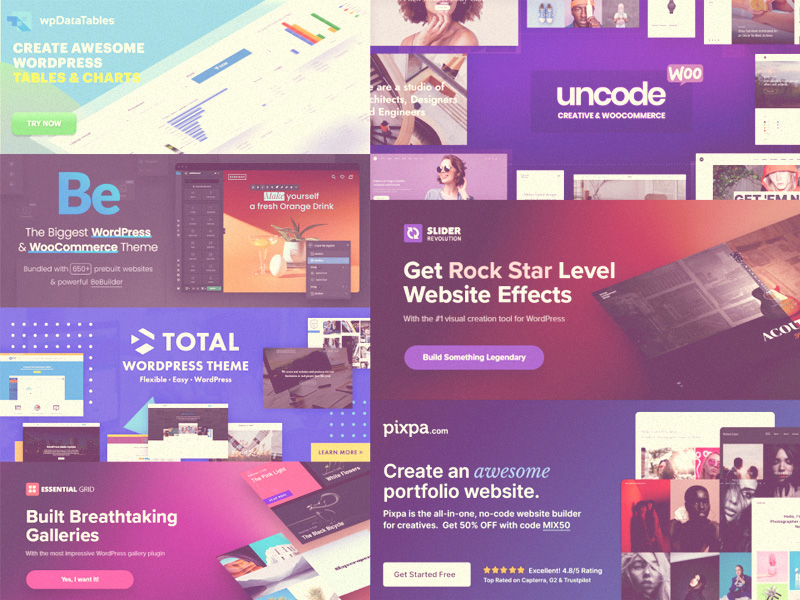
Web design tools and resources can be a big help when it comes to streamlining the creative process and creating stunning websites. There is a seemingly endless variety of free and premium web design products to choose from. They range from complete platforms to specialist software applications. Just like design frameworks and wire framing tools.
We’re not going to pretend that creating wow-worthy websites is always easy. But the design tools you use can often do much of the heavy lifting and help you work efficiently. You can complete projects on time, and exceed clients’ expectations. The rest is up to you.
In any event, the right design tools can help you bring your creative vision to life. With this in mind, here are 13 Best Tools & Resources for Designers and Agencies that we believe are worth a close look.

Both popular (250,000 customers), and powerful (40+ core features), BeTheme is the best multipurpose WordPress theme you could have to create a website that will effectively showcase your creativity and boost your brand.
More than a best-in-class multipurpose website builder, BeTheme places at your fingertips the following best-in-their-class builders:
- BeBuilder, the fastest, lightest, and most intuitive website builder you’ll find for WordPress. View each element while customizing it.
- Be’s WooBuilder gives you a simple yet effective approach to creating an online store.
- Be’s Header Builder 2.0 makes it easy to quickly create the pixel-perfect header you need.
- BeBlocks, a time-saving library of pre-designed sections.
Add Be’s library of 650+ customizable pre-built websites, and it becomes apparent how flexible and powerful BeTheme is. A completely reorganized dashboard makes BeTheme easy to work with and an updated Setup Wizard helps you get your first project underway, step by step. You can test the impressive Be Builder’s capabilities in this Live Demo.
Click on the banner to find out more about BeTheme and its many powerful core features.

You could choose to automate your business’s booking operations by searching for and selecting specialized tools to book appointments, process payments, manage your employee’s schedules, etc. Should your business offer its services at multiple locations, simply repeat the process for each location.
Or you could go with Trafft’s service business management software solution and do everything from a single platform and dashboard.
- There’s no waiting with Trafft. Your clients can book and manage their appointments online 24/7.
- Your clients can also make payments online using Mollie, Stripe, PayPal, or Authorize .net.
- Reminders and notifications can be sent automatically via Mailchimp or SendFox.
- Virtual meetings with clients/employees can be conducted via Zoom.
- Trafft integrates smoothly with Outlook Calendar, Google Calendar, and Google Meet.
Click on the banner to find out more about this time and money saving service business software solution.
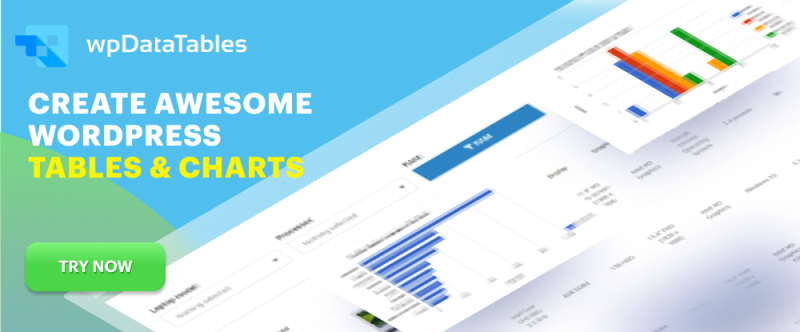
With the wpDataTables plugin in your design toolbox you can create charts and tables that you’ve been hesitant to try building up to now. Such as:
- Lots of table types and charts that are informative, editable, responsive, and attractive.
- tables or charts that require data from a variety of sources and in a variety of formats.
wpDataTables does all the above quickly and efficiently with –
- its ability to organize and process huge amounts of data.
- Its 4 popular chart-building engines
- its powerful sorting and filtering tools
- editability features that allow users to access and edit their own entries
- its Conditional Formatting feature that allows you to highlight or color-code key data.
Click on the banner to find out more about wpDataTables, the best tables and charts WordPress table plugin.
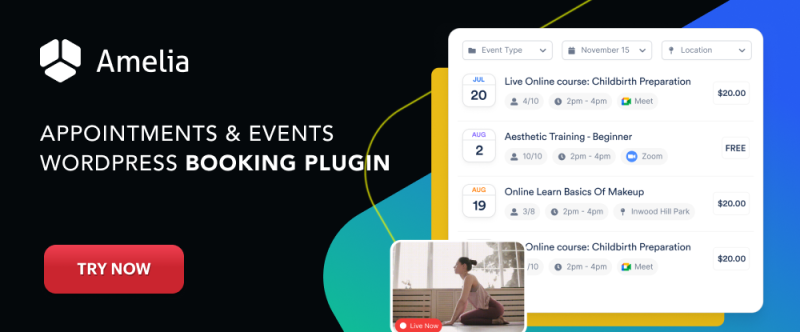
Add the Amelia appointments and events WordPress booking plugin functionality to a website and amazing things happen.
- The website’s user suddenly owns an automated booking system that can flawlessly manage an unlimited number of appointment bookings at multiple locations from a single platform and dashboard.
- Beauty, healthcare, fitness, consulting, educational, and similar client-oriented businesses can benefit.
- Individual bookings, group bookings, and events can be made, and clients can receive SMS or Email notifications.

The Uncode creative WordPress theme is one of the top selling Envato themes of all times with more than 100,000 sales to date.
You can –
- mix and match 70+ importable pre-made designs to build any type of website.
- build incredible WooCommerce websites using the advanced drag and drop product builder and the impressive selection of shop layouts.
- import 550+ section templates with the bundled Wireframes plugin to create landing pages or a complete website.

If you’re in the market for a top-rated (4.8/5) easy website builder for designers Pixpa is worth a good, close look.
Pixpa’s features include –
- 150+ customizable templates you can use to create a professional looking website that reflects your personal style and brand.
- A drag and drop editor that eliminates any need for coding.
- Everything needed to create a portfolio, a store, or a blog platform.
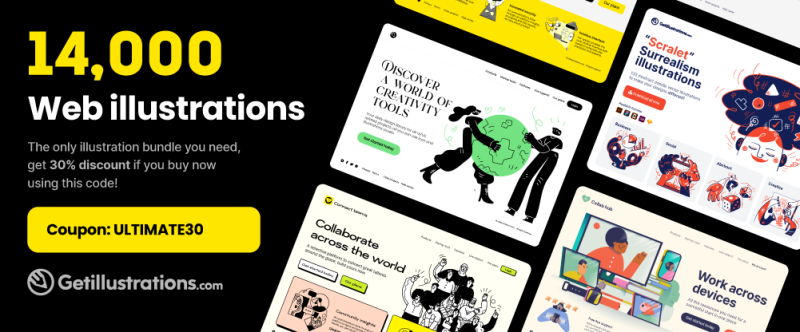
Once a hot design trend, UI illustrations are here to stay. Certain styles may vary in popularity over time, but with 14,000+ ready to use illustrations in nearly 200 categories you should have no problem finding what you need.
With GetIllustrations you can –
- receive weekly new illustrations and updates
- download them once and use them forever
- receive a 30% discount using coupon code: ULTIMATE30
Illustrations are available in PNG, SVG, Ai, Figma, Sketch formats.
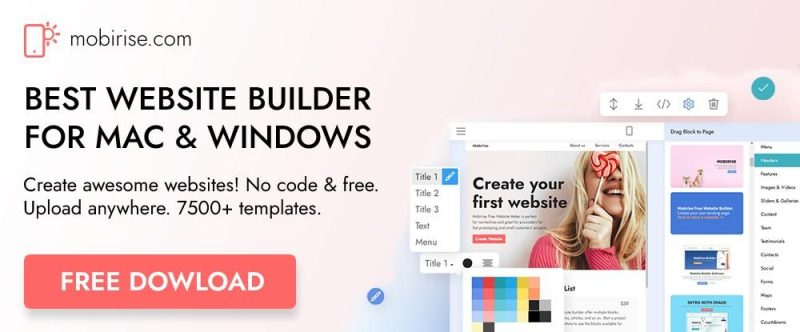
Mobirise is a free offline downloadable website building software app for Windows and Mac. It is perfect for non-techies, and great for developers and web agencies for fast prototyping and small customers’ projects.
With Mobirise –
- you get 7500+ awesome building blocks
- you have an extremely easy-to-use interface to work with
- you can host you site anywhere, and Mobirise is free for commercial use.

Slider Revolution has always been a leading slider plugin, but it’s much more than a WordPress slider plugin now.
- Slider Revolution can be counted on to create visuals your clients will absolutely love.
- Slider Revolution’s innovative website animation effects are accessible to anyone. There’s no need to know code.
- Slider Revolution’s 250+ website and slider templates are designed to impress.

WoodMart, ThemeForest’s most highly regarded WooCommerce WordPress theme, is loaded with features you won’t find in most other eCommerce-oriented themes.
They include –
- shop and product page Elementor builders including an Elementor custom checkout feature
- a header builder, AJAX filters and search capabilities, and product swatches
- 80+ prebuilt websites to get projects off to a quick start.
- 400+ templates that can also be used for quick prototyping
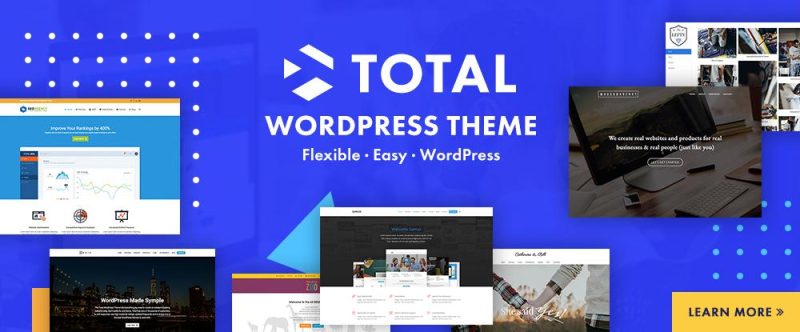
Total is an aptly named WordPress theme that is packed with features that make it easy to work with.
Total’s features include –
- 90+ Section Templates, a selection of post entry cards, and 45+ quick-import demos
- an extended version of the popular WPBakery drag and drop builder plus a selection of custom builder elements
- live customizer theme settings that work in combination with dynamic templates and layouts to give you a ton of flexibility.

Essential Grid is hands down the best WordPress grid plugin on the market. Jaw-dropping advanced features you can use to create the most stunning gallery possible include –
- 50+ impressive, customizable grid templates
- Stunning grid layout options including boxed, full-width to full-screen layouts and even, masonry and cobble grid items; all of which are customizable.
- Fast & responsive designs that allow you to control how your grids appear on various devices.

If it’s lighter and faster than most similar WordPress themes, it’s packed with dozens of cool features, it’s eCommerce ready, and it’s free, it must be Blocksy, the best free eCommerce WordPress theme on the market.
Blocksy’s hyper-intuitive features and customizing options give you complete control over your layout and include:
- advanced WooCommerce integration
- header builder and footer builder
- custom post types & dynamic data support
- integration with Gutenberg, Elementor, Beaver Builder, Brizy and TutorLMS.
Designing a beautiful, responsive website has become easier over the years. All because more and better web design tools and resources have appeared on the market. Since web designers’ specific needs often change from project to project, having a well-rounded tool kit is essential.
There are many essential design tools and resources out there to help you stay on top of the latest web design trends. The web is full of resources you can use to level up your web design skills.
This collection of 13 best tools and resources for 2023 is posted with the intent of helping you. You can create a successful online presence for your business or build upon an existing one.
WORDPRESS
[GET] The7 Website And Ecommerce Builder For WordPress
The7 website and ecommerce builder for wordpress is the most customizable WordPress, Elementor, and WooCommerce theme available on the market up to …
Source link
WORDPRESS
Making 43% of the Web More Dynamic with the WordPress Interactivity API – WordPress.com News

Creating rich, engaging, and interactive website experiences is a simple way to surprise, delight, and attract attention from website readers and users. Dynamic interactivity like instant search, form handling, and client-side “app-like” navigation where elements can persist across routes, all without a full page reload, can make the web a more efficient and interesting place for all.
But creating those experiences on WordPress hasn’t always been the easiest or most straightforward, often requiring complex JavaScript framework setup and maintenance.
Now, with the Interactivity API, WordPress developers have a standardized way for doing that, all built directly into core.
The Interactivity API started as an experimental plugin in early 2022, became an official proposal in March 2023, and was finally merged into WordPress core with the release of WordPress 6.5 on April 2, 2024. It provides an easier, standardized way for WordPress developers to create rich, interactive user experiences with their blocks on the front-end.
ELI5: The Interactivity API and the Image Block
Several core WordPress blocks, including the Query Loop, Image, and Search blocks, have already adopted the Interactivity API. The Image block, in particular, is a great way to show off the Interactivity API in action.
At its core, the Image blocks allow you to add an image to a post or page. When a user clicks on an image in a post or page, the Interactivity API launches a lightbox showing a high-resolution version of the image.
The rendering of the Image block is handled server-side. The client-side interactivity, handling resizing and opening the lightbox, is now done with the new API that comes bundled with WordPress. You can bind the client-side interactivity simply by adding the wp-on--click directive to the image element, referencing the showLightbox action in view.js.
You might say, “But I could easily do this with some JavaScript!” With the Interactivity API, the code is compact and declarative, and you get the context (local state) to handle the lightbox, resizing, side effects, and all of the other needed work here in the store object.
actions: {
showLightbox() {
const ctx = getContext();
// Bails out if the image has not loaded yet.
if ( ! ctx.imageRef?.complete ) {
return;
}
// Stores the positons of the scroll to fix it until the overlay is
// closed.
state.scrollTopReset = document.documentElement.scrollTop;
state.scrollLeftReset = document.documentElement.scrollLeft;
// Moves the information of the expaned image to the state.
ctx.currentSrc = ctx.imageRef.currentSrc;
imageRef = ctx.imageRef;
buttonRef = ctx.buttonRef;
state.currentImage = ctx;
state.overlayEnabled = true;
// Computes the styles of the overlay for the animation.
callbacks.setOverlayStyles();
},
...
The lower-level implementation details, like keeping the server and client side in sync, just work; developers no longer need to account for them.
This functionality is possible using vanilla JavaScript, by selecting the element via a query selector, reading data attributes, and manipulating the DOM. But it’s far less elegant, and up until now, there hasn’t been a standardized way in WordPress of handling interactive events like these.
With the Interactivity API, developers have a predictable way to provide interactivity to users on the front-end. You don’t have to worry about lower-level code for adding interactivity; it’s there in WordPress for you to start using today. Batteries are included.
How is the Interactivity API different from Alpine, React, or Vue?
Prior to merging the Interactivity API into WordPress core, developers would typically reach for a JavaScript framework to add dynamic features to the user-facing parts of their websites. This approach worked just fine, so why was there a need to standardize it?
At its core, the Interactivity API is a lightweight JavaScript library that standardizes the way developers can build interactive HTML elements on WordPress sites.
Mario Santos, a developer on the WordPress core team, wrote in the Interactivity API proposal that, “With a standard, WordPress can absorb the maximum amount of complexity from the developer because it will handle most of what’s needed to create an interactive block.”
The team saw that the gap between what’s possible and what’s practical grew as sites became more complex. The more complex a user experience developers wanted to build, the more blocks needed to interact with each other, and the more difficult it became to build and maintain sites. Developers would spend a lot of time making sure that the client-side and server-side code played nicely together.
For a large open-source project with several contributors, having an agreed-upon standard and native way of providing client-side interactivity speeds up development and greatly improves the developer experience.
Five goals shaped the core development team’s decisions as they built the API:
- Block-first and PHP-first: Prioritizing blocks for building sites and server side rendering for better SEO and performance. Combining the best for user and developer experience.
- Backward-compatible: Ensuring compatibility with both classic and block themes and optionally with other JavaScript frameworks, though it’s advised to use the API as the primary method. It also works with hooks and internationalization.
- Declarative and reactive: Using declarative code to define interactions, listening for changes in data, and updating only relevant parts of the DOM accordingly.
- Performant: Optimizing runtime performance to deliver a fast and lightweight user experience.
- Send less JavaScript: Reduce the overall amount of JavaScript being sent on the page by providing a common framework that blocks can reuse. So the more that blocks leverage the Interactivity API, the less JavaScript will be sent overall.
Other goals are on the horizon, including improvements to client-side navigation, as you can see in this PR.
Interactivity API vs. Alpine
The Interactivity API shares a few similarities to Alpine—a lightweight JavaScript library that allows developers to build interactions into their web projects, often used in WordPress and Laravel projects.
Similar to Alpine, the Interactivity API uses directives directly in HTML and both play nicely with PHP. Unlike Alpine, the Interactivity API is designed to seamlessly integrate with WordPress and support server-side rendering of its directives.
With the interactivity API, you can easily generate the view from the server in PHP, and then add client-side interactivity. This results in less duplication, and its support in WordPress core will lead to less architectural decisions currently required by developers.
So while Alpine and the Interactivity API share a broadly similar goal—making it easy for web developers to add interactive elements to a webpage—the Interactivity API is even more plug-and-play for WordPress developers.
Interactivity API vs. React and Vue
Many developers have opted for React when adding interactivity to WordPress sites because, in the modern web development stack, React is the go-to solution for declaratively handling DOM interactivity. This is familiar territory, and we’re used to using React and JSX when adding custom blocks for Gutenberg.
Loading React on the client side can be done, but it leaves you with many decisions: “How should I handle routing? How do I work with the context between PHP and React? What about server-side rendering?”
Part of the goal in developing the Interactivity API was the need to write as little as little JavaScript as possible, leaving the heavy lifting to PHP, and only shipping JavaScript when necessary.
The core team also saw issues with how these frameworks worked in conjunction with WordPress. Developers can use JavaScript frameworks like React and Vue to render a block on the front-end that they server-rendered in PHP, for example, but this requires logic duplication and risks exposure to issues with WordPress hooks.
For these reasons, among others, the core team preferred Preact—a smaller UI framework that requires less JavaScript to download and execute without sacrificing performance. Think of it like React with fewer calories.
Luis Herranz, a WordPress Core contributor from Automattic, outlines more details on Alpine vs the Interactivity API’s usage of Preact with a thin layer of directives on top of it in this comment on the original proposal.
Preact only loads if the page source contains an interactive block, meaning it is not loaded until it’s needed, aligning with the idea of shipping as little JavaScript as possible (and shipping no JavaScript as a default).
In the original Interactivity API proposal, you can see the run-down and comparison of several frameworks and why Preact was chosen over the others.
What does the new Interactivity API provide to WordPress developers?
In addition to providing a standardized way to render interactive elements client-side, the Interactivity API also provides developers with directives and a more straightforward way of creating a store object to handle state, side effects, and actions.
Directives
Directives, a special set of data attributes, allow you to extend HTML markup. You can share data between the server-side-rendered blocks and the client-side, bind values, add click events, and much more. The Interactivity API reference lists all the available directives.
These directives are typically added in the block’s render.php file, and they support all of the WordPress APIs, including actions, filters, and core translation APIs.
Here’s the render file of a sample block. Notice the click event (data-wp-on--click="actions.toggle"), and how we bind the value of the aria-expanded attributes via directives.
<div
<?php echo get_block_wrapper_attributes(); ?>
data-wp-interactive="create-block"
<?php echo wp_interactivity_data_wp_context( array( 'isOpen' => false ) ); ?>
data-wp-watch="callbacks.logIsOpen"
>
<button
data-wp-on--click="actions.toggle"
data-wp-bind--aria-expanded="context.isOpen"
aria-controls="<?php echo esc_attr( $unique_id ); ?>"
>
<?php esc_html_e( 'Toggle', 'my-interactive-block' ); ?>
</button>
<p
id="<?php echo esc_attr( $unique_id ); ?>"
data-wp-bind--hidden="!context.isOpen"
>
<?php
esc_html_e( 'My Interactive Block - hello from an interactive block!', 'my-interactive-block' );
?>
</p>
</div>
Do you need to dynamically update an element’s inner text? The Interactivity API allows you to use data-wp-text on an element, just like you can use v-text in Vue.
You can bind a value to a boolean or string using wp-bind– or hook up a click event by using data-wp-on–click on the element. This means you can write PHP and HTML and sprinkle in directives to add interactivity in a declarative way.
Handling state, side effects, and actions
The second stage of adding interactivity is to create a store, which is usually done in your view.js file. In the store, you’ll have access to the same context as in your render.php file.
In the store object, you define actions responding to user interactions. These actions can update the local context or global state, which then re-renders and updates the connected HTML element. You can also define side effects/callbacks, which are similar to actions, but they respond to state changes instead of direct user actions.
import { store, getContext } from '@wordpress/interactivity';
store( 'create-block', {
actions: {
toggle: () => {
const context = getContext();
context.isOpen = ! context.isOpen;
},
},
callbacks: {
logIsOpen: () => {
const { isOpen } = getContext();
// Log the value of `isOpen` each time it changes.
console.log( `Is open: ${ isOpen }` );
},
},
} );
Try it out for yourself
The Interactivity API is production-ready and already running on WordPress.com! With any WordPress.com plan, you’ll have access to the core blocks built on top of the Interactivity API.
If you want to build your own interactive blocks, you can scaffold an interactive block by running the below code in your terminal:
npx @wordpress/create-block@latest my-interactive-block --template @wordpress/create-block-interactive-template
This will give you an example interactive block, with directives and state handling set up.
You can then play around with this locally, using wp-env, using a staging site, or by uploading the plugin directly to your site running a plugin-eligible WordPress.com plan.
If you want a seamless experience between your local dev setup and your WordPress.com site, try using it with our new GitHub Deployments feature! Developing custom blocks is the perfect use case for this new tool.
The best way to learn something new is to start building. To kick things off, you may find the following resources a good starting point:
Join 106.9M other subscribers
WORDPRESS
The Masters Golf Tournament – WordPress.com News

Congratulations are in order for Scottie Scheffler, the winner of the 2024 Masters Tournament in Augusta, Georgia! In today’s Build and Beyond video, Jamie Marsland takes on the slightly less intimidating task of re-creating the Masters website as quickly as he can. Can he possibly do it in just 30 minutes?
Along the way, you’ll learn about sticky navigation menus, image overflows and breakouts, card layouts, and more.
Interested in a free trial that allows you to test our all that WordPress.com has to offer? Click below:
Join 110M other subscribers
-

 WORDPRESS7 days ago
WORDPRESS7 days agoTurkish startup ikas attracts $20M for its e-commerce platform designed for small businesses
-

 MARKETING6 days ago
MARKETING6 days agoRoundel Media Studio: What to Expect From Target’s New Self-Service Platform
-

 SEO6 days ago
SEO6 days agoGoogle Limits News Links In California Over Proposed ‘Link Tax’ Law
-
SEARCHENGINES6 days ago
Daily Search Forum Recap: April 12, 2024
-

 SEARCHENGINES7 days ago
SEARCHENGINES7 days agoGoogle Search Results Can Be Harmful & Dangerous In Some Cases
-

 SEO5 days ago
SEO5 days ago10 Paid Search & PPC Planning Best Practices
-

 SEARCHENGINES5 days ago
SEARCHENGINES5 days agoGoogle Core Update Volatility, Helpful Content Update Gone, Dangerous Google Search Results & Google Ads Confusion
-

 SEO6 days ago
SEO6 days agoGoogle Unplugs “Notes on Search” Experiment













You must be logged in to post a comment Login